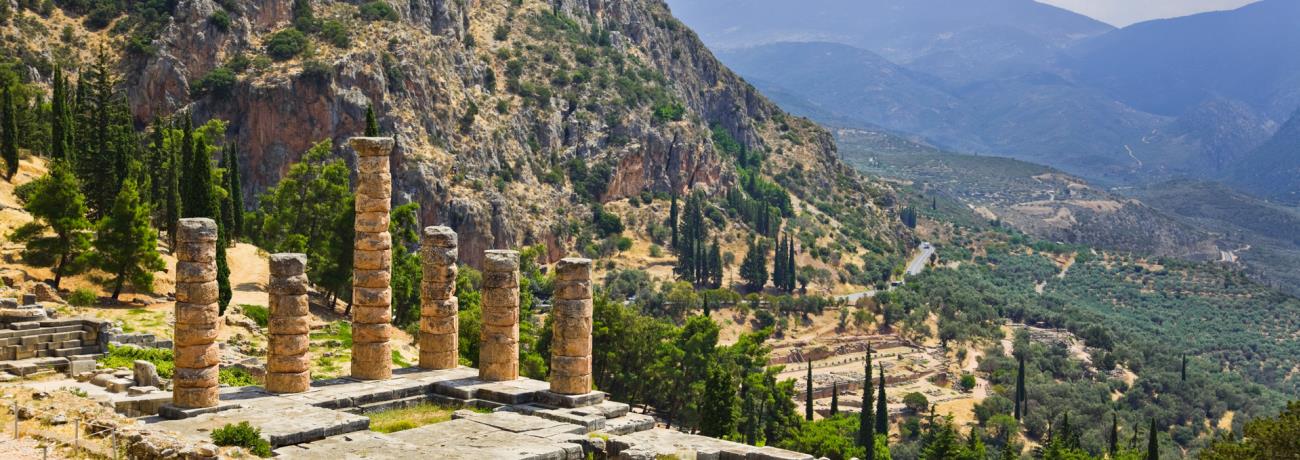Λίκνο ενός από τα σημαντικότερα ιερά της ελληνικής αρχαιότητας και του διασημότερου μαντείου της αποτέλεσε η γη της Φωκίδας και συγκεκριμένα η καταπράσινη κοιλάδα του ποταμού Πλειστού. Στα βόρειά της η κοιλάδα περικλείεται από τους ορεινούς όγκους του Παρνασσού και της Κίρφης, ενώ το νότιο τμήμα της ανοίγεται στη θάλασσα του Κορινθιακού, σχηματίζοντας βαθύ κόλπο, όπου το λιμάνι της σημερινής Ιτέας. Χάρη στη γεωγραφική της θέση, στην καρδιά της κεντρικής Ελλάδας, η περιοχή των Δελφών, αποτελεί ένα σταυροδρόμι όπου ενώνονται τα φυσικά περάσματα από τη δυτική στην ανατολική Στερεά και από τη Θεσσαλία στην Αττική. Για τους αρχαίους όμως ήταν κάτι πολύ περισσότερο. Κάποτε, λέει ο μύθος, ο Δίας έστειλε δύο αετούς από τις άκρες του κόσμου για να βρουν τον ομφαλό, το κέντρο της γης. Και οι αετοί συναντήθηκαν στους Δελφούς.
Ένα ιερό καθρέφτης της ελληνικής ιστορίαςΣτη θέση του ιερού των Δελφών προϋπήρχε μυκηναϊκός οικισμός (1400-1100 π.Χ.), ο οποίος έδωσε και τις πρώτες ενδείξεις για την ανάπτυξη εδώ μιας λατρείας γυναικείας θεότητας. Ο μύθος κάνει λόγο για την πανάρχαια λατρεία της Μητέρας Γης, που στα τέλη του 9ου αι. π.Χ. παραχώρησε τη θέση της στη λατρεία του Απόλλωνα.
Η ιστορία του ιερού και του μαντείου των Δελφών είναι άρρηκτα δεμένη, στα 1500 περίπου χρόνια που έζησε, με την ιστορία όχι μόνο της Ελλάδας αλλά και του τότε γνωστού κόσμου. Στο δελφικό χρησμό καταφεύγουν ισχυροί μονάρχες της Ανατολής, ενώ δεν υπάρχει μείζον γεγονός στην αρχαία ελληνική ιστορία στο οποίο άμεσα ή έμμεσα να μην έλαβε μέρος ή να μην πήρε θέση το δελφικό μαντείο. Με τα πλούτη και την επιρροή του θα γίνει μήλον της έριδος μεταξύ των Ελλήνων, αλλά και μαγνήτης των ξένων εισβολέων.
Με την επικράτηση του Χριστιανισμού, ο Φοίβος θα στερηθεί τη στέγη του και η Πυθία θα σιγήσει. Ο τελευταίος χρησμός του μαντείου των Δελφών στον αυτοκράτορα Ιουλιανό τον Παραβάτη (360-363 μ.Χ.) θα είναι και το κύκνειο άσμα του. Το 394 μ.Χ. με το διάταγμα του αυτοκράτορα Θεοδοσίου Α΄ η αρχαία λατρεία και η λειτουργία των ιερών της απαγορεύτηκαν. Ένα χρόνο πριν τελέστηκαν οι τελευταίοι Ολυμπιακοί αγώνες της αρχαιότητας.
Με την πάροδο του χρόνου το ιερό θάβεται κάτω από τις κατολισθήσεις βράχων και χωμάτων, αναπόφευκτη συνέπεια των σεισμών και της εγκατάλειψης. Στα μεσαιωνικά χρόνια τη θέση του καταλαμβάνει το χωριό Καστρί, πρόδρομος της σύγχρονης κωμόπολης των Δελφών. Η μνήμη του χώρου όμως παρέμεινε στις γραπτές πηγές, η θέση του εντοπίστηκε και ταυτίστηκε από τους νεότερους περιηγητές. Το 1892 εγκαινιάζονται οι ανασκαφές της Γαλλικής Αρχαιολογικής Σχολής, που θα φέρουν στο φως τα πολυθρύλητα ερείπια.
Στον ιερό χώρο των Δελφών ο ποιητής Άγγελος Σικελιανός οραματίστηκε τη δημιουργία μιας παγκόσμιας πνευματικής αμφικτιονίας, αυτό που ο ίδιος ονόμασε Δελφική προσπάθεια.Το 1927 και 1930 πραγματοποιούνται από τον ποιητή και τη σύζυγό του Εύα οι Δελφικές Εορτές, που θα μείνουν στην ιστορία ως οι πρώτες σύγχρονες παραστάσεις αρχαίας τραγωδίας στο φυσικό της χώρο του αρχαίου θεάτρου. Το 1977 ιδρύεται το Ευρωπαϊκό Πολιτιστικό Κέντρο Δελφών υπό την αιγίδα του Υπουργείου Πολιτισμού και του Συμβουλίου της Ευρώπης, με στόχο να αποτελέσει φορέα προαγωγής του ευρωπαϊκού πολιτισμού. Μια δεκαετία αργότερα οι Δελφοί θα συμπεριληφθούν στον κατάλογο των Μνημείων Παγκόσμιας Κληρονομιάς της UNESCO.
Τα μνημείαΕκστατικός μένει ο θεατής που πρωτοαντικρίζει το δελφικό ιερό απλωμένο στη βάση των δύο θεόρατων βράχων του Παρνασσού, των Φαιδριάδων. Εδώ ανοίγεται το συγκλονιστικό χάσμα, που στους ατμούς του οι αρχαίοι έβλεπαν το πνεύμα του θεού και στο μυχό του αναβλύζει η ιερή πηγή της Κασταλίας.
Ο σημερινός επισκέπτης, όπως και ο αρχαίος προσκυνητής, το πρώτο ιερό που συναντά ερχόμενος στους Δελφούς από το δρόμο Αράχοβας - Δελφών είναι το τέμενος της Προναίας Αθηνάς. Το επίθετο δηλώνει τη θεά που τιμάται προ του ναού του Απόλλωνα και ο μύθος λέει ότι η θέση παραχωρήθηκε στην Αθηνά από το θεό, ως ευχαριστία για τη βοήθεια που του προσέφερε στον αγώνα του με το τερατώδες φίδι Πύθωνα. Στο ιερό αυτό βρίσκεται η περίφημη θόλος των Δελφών, ένα από τα στολίδια της αρχαίας αρχιτεκτονικής. Τα κυκλικά αυτά κτίρια, που συναντούμε και σε άλλα ιερά, όπως στην Επίδαυρο και στην Ολυμπία, συνδέονται με τη λατρεία ηρώων ή χθόνιων θεοτήτων, αν και δεν υπάρχουν αρχαίες μαρτυρίες που να επιβεβαιώνουν τη χρήση τους. Η θόλος των Δελφών χρονολογείται στις αρχές του 4ου αι. π.Χ. και θεωρείται έργο ενός σημαντικού αρχιτέκτονα της αρχαιότητας, του Θεόδωρου.
Αφήνοντας πίσω μας το τέμενος της Προναίας, ανηφορίζουμε στο ιερό του Απόλλωνα. Η τραχύτητα του αμφιθεατρικού τοπίου προδίδει και τη μεγαλύτερη πρόκληση που είχαν να αντιμετωπίσουν οι αρχαίοι τεχνίτες. Για την εξομάλυνση του φυσικού εδάφους χρειάστηκε να κατασκευάσουν ισχυρούς αναλημματικούς τοίχους, διαμορφώνοντας αλλεπάλληλα επίπεδα πάνω στα οποία εδράζονταν τα μνημεία. Το ίδιο το τέμενος περικλείστηκε από περίβολο, στη ΝΑ γωνία του οποίου βρισκόταν η κύρια είσοδος, που και σήμερα χρησιμοποιείται για την είσοδο και έξοδο των επισκεπτών στο χώρο.
Από εδώ άρχιζε η Ιερά Οδός, το αρχαίο φιδωτό μονοπάτι, που διέτρεχε το ιερό. Ακολουθώντας το, ο σημερινός επισκέπτης, καθώς περπατά ανάμεσα στα ερείπια, θα πρέπει να ανασυνθέσει την εικόνα ενός ιερού, κατακλυσμένου από κομψά κτίρια, βωμούς και ελεύθερα αναθήματα, που σε πυκνή διάταξη καταλαμβάνουν το χώρο κατά μήκος της Ιεράς Οδού και περιμετρικά του ναού του Απόλλωνα, που δεσπόζει σε υπερυψωμένη θέση στο κέντρο. Ο δωρικός ναός που σώζεται σήμερα ανεγέρθηκε την εποχή της βασιλείας του Μ. Αλεξάνδρου, το 330 π.Χ. Μέσα σε αυτό το ναό, η Πυθία, καθισμένη στο μαντικό τρίποδα, μετέφερε τα λόγια του θεού, ενώ μπροστά από το άδυτο έκαιγε το άσβεστο ιερό πυρ, τροφοδοτούμενο από ξύλα έλατου και δάφνης.
Ο θησαυρός των Σιφνίων του 6ου αι. π.Χ. είναι το αρχαιότερο οικοδόμημα της ηπειρωτικής Ελλάδας εξολοκλήρου κατασκευασμένο από το περίφημο παριανό μάρμαρο, ενώ αγάλματα κορών στήριζαν την πρόσταση του μνημείου, όπως έναν αιώνα αργότερα στο Ερέχθειο της Ακρόπολης. Στον δικό τους θησαυρό, όπως και στη στοά που ανήγειραν, οι Αθηναίοι τοποθέτησαν τα λάφυρα από τις νικηφόρες μάχες και ναυμαχίες κατά των Περσών. Στην εξωτερική πλευρά των τοίχων του θησαυρού χαράχτηκαν κατά τον 3ο αι. π.Χ. δύο ύμνοι του Απόλλωνα με τα αρχαία μουσικά σημάδια, τα οποία απαντούμε και σε παπύρους, ένα εξαιρετικά σπάνιο εύρημα.
Στη ΒΔ γωνία του ιερού, σκαρφαλωμένο σε μια πλαγιά με πανοραμική θέα του δελφικού τοπίου, βρίσκεται το θέατρο των Δελφών, χτισμένο το 400 π.Χ. με λευκή πέτρα του Παρνασσού. Η χωρητικότητά του υπολογίζεται σε 5000 θεατές και φέρει όλα τα τυπικά αρχιτεκτονικά γνωρίσματα των υστεροκλασικών ελληνικών θεάτρων. Ακόμη ψηλότερα, ένα μονοπάτι οδηγεί από το θέατρο στο στάδιο, το οποίο διαμορφώθηκε κατά τον 5ο αι. π.Χ. και είχε τη δυνατότητα να χωρέσει 7000 θεατές. Στο θέατρο και στο στάδιο τελούνταν οι μουσικοί και αθλητικοί αντίστοιχα αγώνες των Πυθίων, των εορτών προς τιμήν του Απόλλωνα. Για την προπόνηση των αθλητών χρησίμευε το γυμνάσιο που στην περίπτωση των Δελφών είναι το πιο ολοκληρωμένο παράδειγμα αρχαίου γυμνασίου που έχει διασωθεί. Τον 2ο αι. μ.Χ. θα κατασκευαστούν οι θέρμες, τα θερμά λουτρά που γίνονται «μόδα» στα ελληνικά γυμναστήρια και όχι μόνο μετά τη ρωμαϊκή κατάκτηση. Στα ελληνιστικά χρόνια το Γυμνάσιο εξελίσσεται σε ένα είδος πνευματικού κέντρου, όπου συναθροίζονται και δίνουν τις διαλέξεις τους σημαίνοντες εκπρόσωποι των τεχνών και των γραμμάτων.
| Γ. Μήκος | 22o 30' 04.8" E |
| Γ. Πλάτος | 38o 28' 56.27" N |
| Χαρακτηρισμός τόπου | UNESCO - Μνημείο Παγκόσμιας Κληρονομιάς, Ιδανικά για πεζοπορία, Τα 5 περίφημα μαντεία της αρχαιότητας, Αρχαιολογικός χώρος, Αρχαίο Θέατρο, Αρχαίο στάδιο |
| Ταχ. Κωδικός | 33054 |
Λάβετε το καθημερινό newsletter με τα πιο σημαντικά νέα της τουριστικής βιομηχανίας.
Εγγραφείτε τώρα!


